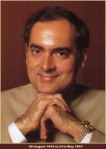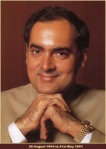 Elected to Sanjay’s Lok Sabha constituency of Amethi in Uttar Pradesh state in February 1981, Rajiv Gandhi became an important political advisor to his mother. It was widely perceived that Indira Gandhi was grooming Rajiv for the prime minister’s job, and he soon became the president of the Youth Congress – the Congress party’s youth wing.
Elected to Sanjay’s Lok Sabha constituency of Amethi in Uttar Pradesh state in February 1981, Rajiv Gandhi became an important political advisor to his mother. It was widely perceived that Indira Gandhi was grooming Rajiv for the prime minister’s job, and he soon became the president of the Youth Congress – the Congress party’s youth wing.
Rajiv Gandhi was in West Bengal when his mother, Indira Gandhi was assassinated on 31 October 1984 by two of her Sikh bodyguards, Satwant Singh and Beant Singh, to avenge the military attack on the Harmandir Sahib, Sikhism’s holiest shrine, also called “The Golden Temple” during Operation Blue Star. Top Congress leaders, as well as President Zail Singh pressed Rajiv to become India’s Prime Minister, within hours of his mother’s assassination. Soon after assuming office, Rajiv asked President Zail Singh to dissolve Parliament and hold fresh elections, as the Lok Sabha completed its five year term. Rajiv Gandhi also officially became the President of the Congress party. The Congress party won a landslide victory – with the largest majority in history of Indian Parliament— giving Gandhi absolute control of government. He also benefited from his youth and a general perception of being free of a background in corrupt politics.
He increased government support for science and technology and associated industries, and reduced import quotas, taxes and tariffs on technology-based industries, especially computers, airlines, defence and telecommunications. He introduced measures significantly reducing the License Raj, allowing businesses and individuals to purchase capital, consumer goods and import without bureaucratic restrictions.[1] In 1986, he announced a National Policy on Education to modernise and expand higher education programs across India. He founded the Jawahar Navodaya Vidyalaya System in 1986 which is a Central government based institution that concentrates on the upliftment of the rural section of the society providing them free residential education from 6th till 12 grade. His efforts created MTNL in 1986, and his public call offices, better known as PCOs, helped spread telephones in rural areas.
Rajiv Gandhi began leading in a direction significantly different from his mother’s socialism. He improved bilateral relations with the United States – long strained owing to Indira’s socialism and friendship with the USSR — and expanded economic and scientific cooperation. During his state visit to the Soviet Union he met with Premier Nikolai Tikhonov, Andrey Gromyko of the Ministry of Foreign Affairs and Mikhail Gorbachev.
Rajiv authorised an extensive police and army campaign to contain terrorism in Punjab. A state of martial law existed in the Punjab state, and civil liberties, commerce and tourism were greatly disrupted. There are many accusations of human rights violations by police officials as well as by the militants during this period. It is alleged that even as the situation in Punjab came under control, the Indian government was offering arms and training to the LTTE rebels fighting the government of Sri Lanka. The Indo-Sri Lanka Peace Accord was signed by Rajiv Gandhi and the Sri Lankan President J.R.Jayewardene, in Colombo on 29 July 1987. The very next day, on 30 July 1987, Rajiv Gandhi was assaulted on the head with a rifle butt by a young Sinhalese naval cadet named Vijayamunige Rohana de Silva, while receiving the honour guard. The intended assault on the back of Rajiv Gandhi’s head glanced off his shoulder.
With his speech while addressing the Joint Session of the US Congress and India, he said, “India is an old country, but a young nation; and like the young everywhere, we are impatient. I am young and I too have a dream. I dream of an India, strong, independent, self reliant and in the forefront of the front ranks of the nations of the world in the service of mankind.”[18]
His period in office was marred by scandals and allegations of corruption on so huge a scale that he undoubtedly lost the election of 1989 partly on account of the public perception that he had received “kick-backs” from a Swedish company manufacturing Bofors machine-guns. The Congress suffered an electoral defeat. His successor, Vishwanath Pratap Singh, could not hold office for very long, and Rajiv started campaigning in earnest in 1991.
It was while he was on this campaign in South India that a bomb explosion took his life; even his body could not be pieced together. Rajiv Gandhi’s last public meeting was at Sriperumbudur on 21 May 1991, in a village approximately 30 miles from Chennai, Tamil Nadu, where he was assassinated while campaigning for the Sriperumbudur Lok Sabha Congress candidate. The assassination was carried out by the Liberation Tigers of Tamil Eelam.
At 10:10 pm,a woman (later identified as Thenmuli Rajaratnam) approached Rajiv Gandhi in a public meeting and greeted him. She then bent down to touch his feet and detonated a belt laden with 700 grams of RDX explosives tucked under her dress. The explosion killed Rajiv Gandhi and at least 14 other people. The assassination was caught on film through the lens of a local photographer, whose camera and film were found at the site. The cameraman himself died in the blast but the camera remained intact. The Rajiv Gandhi Memorial was built at the site recently and is one of the major tourist attractions of the small industrial town
